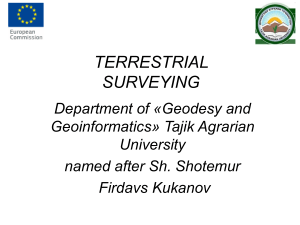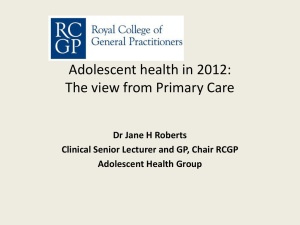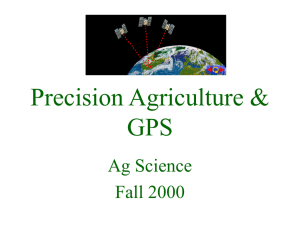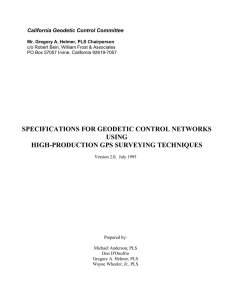Order
advertisement
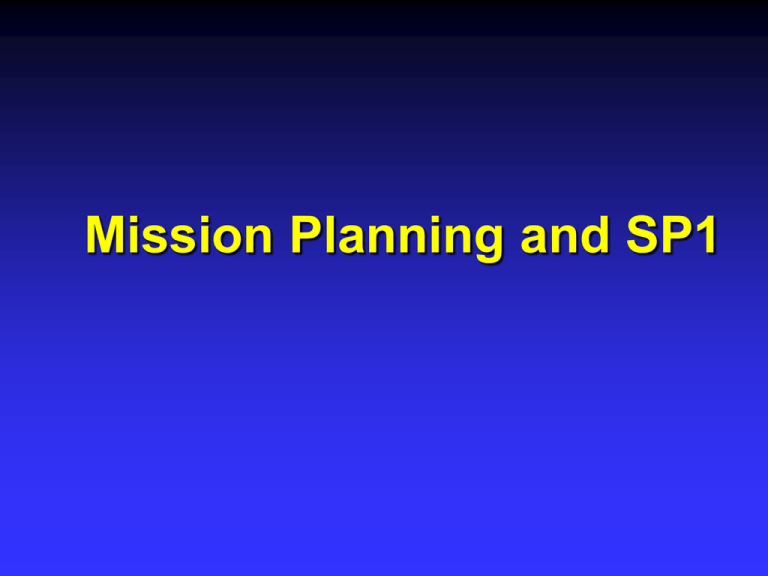
Mission Planning and SP1 Outline of Session Standards Errors Planning Network Design Adjustment ICSM Standards and Practices for Control Surveys ‘SP1’ Positional Uncertainty 95% circle of uncertainty (metres) Independent of the nearby network SP1 ‘the uncertainty, in metres, at the 95% confidence level, with respect to the defined reference frame (in our case GDA94)’ Order is relative – PU is absolute From 2005, PU replaces Order Assigning Positional Uncertainty Formula in SP1 by Leenhouts, 1985 C = b/a K = q0 + q1C + q2C2 + q3C3 Radius = aK Where: a = semi-major axis of the standard error ellipse b = semi-minor axis of the standard error ellipse. q0 = 1.960790 q1 = 0.004071 q2 = 0.114276 q3 = 0.371625 Local Uncertainty 95% confidence level Average relative uncertainty with respect to adjacent points Similar to Order which refers to 1s Same formula as PU but error ellipse refers to ‘relative’ average between adjacent points Class and Order Quality Indicators Determined by The field and reduction procedures of the survey. The quality of the origin data Adjustments are an important element of verifying Class and Order Class “CLASS is a function of the precision of a survey network, reflecting the precision of observations as well as suitability of network design, survey methods, instruments and reduction techniques used in that survey. Preferably the CLASS is verified by an analysis of the minimally constrained least squares adjustment of the network.” Class is determined by The network design. Observing procedures and practices. Reduction of observations. The results of a minimally constrained adjustment. Testing Class The semi major axis of each relative error ellipse is tested against:r = c(d + 0.2) r = Maximum allowable semi-major axis in mm c = Factor to relate Distance to Error d = Distance between stations in km C Values for Each Class 3A C Value (for 1 sigma) 1 2A 3 A 7.5 B 15 C 30 D 50 Special high precision projects High precision National Geodetic Surveys National and State geodetic surveys Densification of geodetic surveys Survey coordination projects Lower class surveys E 100 Lower class surveys Class Typical Applications r = c (d + 0.2) e.g. Class A 1km GPS Line ~ r = 9mm Relative Error Ellipse <r Order “ORDER is a function of the class of a survey, the conformity of the new data set AND the precision of any transformation process required to convert the results from one datum to another” Order Order is determined in the same way as class but AFTER a fully constrained adjustment The same formula for ‘r’ is used Some Order and C values ORDER C (For one s) 00 0 1 2 3 4 5 1 3 7.5 15 30 50 100 Significance of Class and Order 1st Order 4th Order 1st Order 4th Order 1st Order Class A Class A 4th Order 1st Order Class A 1st Order 4th Order 1st Order GPS Surveying Observations in SP1 Static Surveying Quick Static Surveying Pseudo-kinematic Surveying Kinematic Surveying Real Time Kinematic Surveying (RTK) General Requirements Use of Manufacturer’s Instructions Ancillary Equipment Geodetic Receivers and Software Satellite Geometry, Number and Elevation Need for closure in work and connection to existing geodetic network Connection to GDA and AHD as appropriate Warning on site Dependent Errors GPS Calibration SP1 now deals with GPS calibration before starting GPS campaigns! GPS Field Techniques Vs Class Independent Occupations Occupy the mark another time and gather another data set Ideally separated in time with observations to different set of satellites Ideally occupied from different base station in the case of RTK Back to back but with a new set up of the antenna is the minimum Enables detection of Errors Errors in GPS Surveying Avoiding Errors Specifications and Recommended Practices have been designed to minimize errors GPS Errors can be put in 2 groups... Factors which affect Phase data and thus the GPS Processing Factors external to Processing which can affect the final result Factors Affecting Processing Observation Time Number and Geometry of Satellites Quality of Starting Coordinates Broadcast vs Precise Ephemeris Ionospheric and Tropospheric delay Site Specific Errors such as Multipath All affect ability to correctly solve for ambiguities and / or resulting precision SP1 Covers Processing CLASS 3A 2A A B C D E c-Values (one sigma) 1 3 7.5 15 30 50 100 < 8km D*,DD, FX D*,DD, FX S,DD,FX S,DD,FX S,DD,FX S,DD,FT S,DD,FT 8-25kms D,DD,FX D,DD,FX D,DD,FX S,DD,FX S,DD,FX S,DD,FT S,DD,FT 2550kms D,DD, FX(25)FT(50 D,DD,FX( 25)FT(50) D,DD,FXFT D,DD,FXFT D,DD,FXFT D, T D, T 5090kms D,DD,FT DD or **, T D,FT DD or **, T D,FT DD or **, T D,FT DD or **, T D,FT D,T,NCP D,T,NCP > 90kms D,T D,T D,T D,T D,T D,T D,T S = Single Frequency. D = Dual Frequency. DD = Double difference. FX = Fixed Ambiguity solution. FT = Fixed ambiguity with repaired cycle slips. T = Triple Difference. NCP = Narrow correlation ie DGPS. Factors External to Processing Centring Error Antenna Height Error Number of repeat occupations of sites Quality of existing control to which GPS survey is being fitted Datum Transformation For Heights - quality of Geoid Ellipsoid Separation GPS Survey Planning Survey Planning Station Marking Station Naming Manpower Funding GPS Equipment Available Other Resources key maps, access information, program sheets, booking forms, ancillary equipment Reconnaissance Office Preparation Site Selection Visibility Accessibility Multipath Permanency Future Use Reconnaissance Station Documentation Speedo Traverse Travel Times Special Requirements Field Records Logistics Travel time Setup Observation time Optimum Times Observation and Network Design Networked Observation 2 2 PSMs to be Coordinated Existing Control 2 4 1 1 Networked Observation 2 2 PSMs to be Coordinated Existing Control 2 2 2 2 Observation Design PSMs to be Coordinated Existing Control Radiations are not closed - no check Second Set - Checks Control and New Marks Direct Measurement - extra check - little extra time with GPS - or - Traversed during Cadastral Survey Connections to Control Network Mode Connections to Control Base Station Mode Base 3 2 Base 1 Used for RTK and covered in SP1 Adjustment Minimally Constrained Adjustment Only sufficient constraints in order to achieve a solution. Confirms internal accuracy of data. Computed on ellipsoid of GPS computation. No “N” values are included. Used to assign CLASS to coordinates. Fully Constrained Adjustment All constraints are included. GPS baselines may have to be transformed (say to AGD) as part of the adjustment process. Include ‘N’ Values in this adjustment. Used to assign ORDER to coordinates. Adjustment Analysis Essential to verify Class and Order Variance factor should pass Chi Square test Standardized residuals inspected RTK Questions?
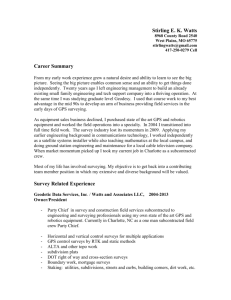


![Astronomic and Geodetic Surveying [Opens in New Window]](http://s3.studylib.net/store/data/006720332_1-995dd15e73ac73d62b2a2d2c1a39992f-300x300.png)


